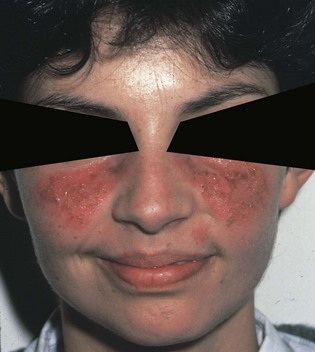108 Systemic Lupus Erythematosus
• Systemic lupus erythematosus is an autoimmune disease that damages the skin, kidneys, bones, lungs, brain, and nearly every other organ in the body.
• The damage is due to inflammation as a result of a direct antibody reaction to body tissues, deposits of immune complexes, and secondary thrombosis.
• A characteristic finding is fever, malar rash, and joint pain in a young, premenopausal woman.
• Sunlight and certain viruses and drugs can induce an autoimmune response in a genetically susceptible host.
• Basic treatment of pain is with nonsteroidal antiinflammatory medications or steroids. Many patients additionally require immunosuppressants, antimalarial drugs, and other therapies prescribed by a rheumatologist.
• Patients with systemic lupus erythematosus have increased risk for serious infection, often because of the steroids and immunosuppressants required to treat the disease.
• Morbidity is due to organ failure, primarily of the kidney and brain.
Perspective
Systemic lupus erythematosus (SLE) is a chronic autoimmune disease with widespread physical effects caused by the production of autoantibodies to components of cellular nuclei.1 The term lupus (Latin for “wolf”) is attributed to the 13th-century physician Rogerius, who used it to describe the characteristic facial lesions that were reminiscent of a wolf’s bite.
Epidemiology
SLE is more common by a ratio of 12 : 1 in women aged 15 to 45 years and by a ratio of 2 : 1 in younger and older women. The overall prevalence of this disease is about 1 in 1000. In most studies of SLE, about 90% of enrollees are women. In the United States, the disease is three times more common in black women than in white women. In addition to genetic factors, age, sex, race, and socioeconomic status have an impact on disease expression and prognosis. With optimal management, the 20-year survival rate approaches 70% and the 1-year survival rate is about 90%.2
Presenting Signs and Symptoms
The triad of fever, joint pain, and rash in a woman of childbearing age suggests SLE. The most well-recognized cutaneous finding is the red, raised butterfly rash (Fig. 108.1), but malaise, fatigue, aches, fever, and weight loss are the most common symptoms. The rash, which does not cross the nasolabial fold, may be painful or pruritic. It may be precipitated by sunlight and can last from days to weeks.

Fig. 108.1 Erythematous malar rash of systemic lupus erythematosus.
Note that the rash does not cross the nasolabial fold.
(From Gladman DD, Urowitz MB. Clinical features. In: Hochberg MC, Silman AJ, Smolen JS, editors. Rheumatology. Philadelphia:, Mosby; 2003. pp. 1359–79.)
More than two thirds of patients have vague constitutional symptoms. A thorough evaluation is required before attributing such symptoms to lupus alone. Patients can have kidney failure, infections, adrenal failure, and other complications with similar symptoms (Box 108.1).
Box 108.1
Criteria for the Classification of Systemic Lupus Erythematosus*
Immunologic Disorder
Positive ANA Test
Abnormal ANA titers by immunofluorescence or an equivalent assay at any time in the absence of drugs
ANA, Antinuclear antibody; anti-Sm, anti-Smith; IgG, immunoglobulin G; IgM, immunoglobulin M.
Modified from Hochberg MC, Silman AJ, Smolen JS, editors. Rheumatology, vol 2. 3rd ed. London: Mosby; 2003, Chapter 122.
* Based on the American Rheumatism Association revised criteria for the classification of lupus. The criteria consist of conditions associated with systemic lupus erythematosus, including clinical symptoms, systemic complications, and diagnostic and laboratory test findings (see text for discussion).
Stay updated, free articles. Join our Telegram channel

Full access? Get Clinical Tree







